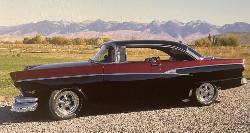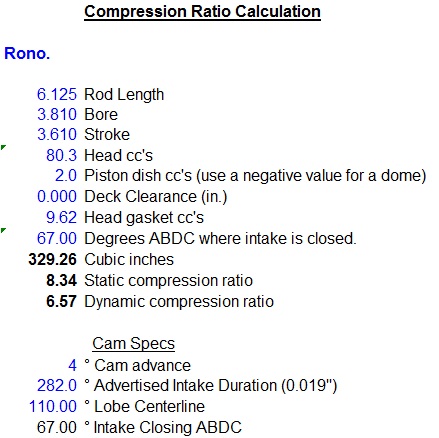|
Author
|
Message
|
|
NoShortcuts
|
|
|
Group: Forum Members
Last Active: 2 Years Ago
Posts: 1.4K,
Visits: 179.6K
|
gyrogary (1/1/2016)
Rono that 12.95" dimension is the circumference and needs to be divided by pi to give you a gasket bore of 4.122" I get 8.528:1 compression or there abouts. YES, Gary! Your approach of using the 'fire ring' measured length (per Ted) as the circumference of a circle to work backwards and transpose it into a bore diameter would permit using the existing Internet computer program. Good Thinking! I believe that we've both come-up with statistically the same compression ratio! Thanks for coming in on this! We've verified each others answers by arriving at them different ways! Ron, I trust you're happy to get this worked through!?!? Best Wishes for a Happy and Healthy New Year to all of you!
NoShortcuts
a.k.a. Charlie Brown
near Syracuse, New York
|
|
|
|
|
Rono
|
|
|
Group: Forum Members
Last Active: Last Year
Posts: 1.3K,
Visits: 80.0K
|
Charlie; Thanks very much for re-calculating the CR for me. Quite a difference from my CR number, but I'm glad it is more accurate than what I came up with. I don't have an accurate way now to calculate the volume of the amount of material I removed when I relieved the block because it is all assembled. I can say that the depth of the reliefs were 1/2 the distance from the top of the piston to the top of the top ring or 1/8" deep (from top of top ring to top of piston was 1/4"). So, I think it would be safe to say that my CR would be between 8.0 and 8.5. Consequently, to keep my EFFECTIVE compression ratio (static compression ratio plus amount of supercharger boost) below 12.1 psi on pump gas (i.e. 92 octane), I need to keep the boost pressure at about 6 psi (not 7 psi as I was planning). You can run more boost if you increase the octane rating, but that can get expensive. Now I can choose my blower pulleys with more confidence. Thanks Again! Rono
 Ron Lane, Meridian, ID Ron Lane, Meridian, ID
|
|
|
|
|
NoShortcuts
|
|
|
Group: Forum Members
Last Active: 2 Years Ago
Posts: 1.4K,
Visits: 179.6K
|
Rono. From your description, methinks you and I have done the same version of Ford y block relieving only at different times. In moving to a 4-71 type SC, do you need to consider swapping cranks? IF swapping to a forged crank has merit, I'll help you do it. Frank Rice and John 'The Hoosier Hurricane' have both mention snout issues with the cast cranks relative to blower drives. It would seem that the Roots type blower would be harder on the crank snout than the vane style you had. This is not my area of knowing a lot about what I'm bringing up. Point is, IF you need assistance in gettin' her done, we're both only going this way once. I want to see you do it the way you want to!  Keep me in mind. Regards,
NoShortcuts
a.k.a. Charlie Brown
near Syracuse, New York
|
|
|
|
|
Rono
|
|
|
Group: Forum Members
Last Active: Last Year
Posts: 1.3K,
Visits: 80.0K
|
Thanks Charlie. I've read about the possible cast crank issue, but I need to block that out of my mind right now. Way too much time and money to consider that at this point of the coupe build.. I need to get that car done! I don't plan on track racing the car and I don't think I'll ever hit 6K RPM on the street, maybe only on the dyno. So, I need to take my chances and stick with the offset ground cast crank for now and hope for the best! I do appreciate the offer though. HAPPY NEW YEAR! Rono
 Ron Lane, Meridian, ID Ron Lane, Meridian, ID
|
|
|
|
|
Ted
|
|
|
Group: Administrators
Last Active: Yesterday
Posts: 7.5K,
Visits: 205.8K
|
Rono (12/31/2015)
.....Also, there is no provision in this calculator for a relieved block. Is there a % reduction ( i.e. 1% or 5%) that can be subtracted from the calculated CR? One method for determining the volume of a cylinder wall valve relief is to simply mold a piece of clay that fits the relief and then measure the amount of fluid that piece of clay displaces in a graduated buret. A large relief would be in the neighborhood of two cc’s. Until you actually cc the heads, you don’t know what you have. As a general rule, they tend to be larger than published values versus being smaller. It will also be to your advantage to cc all the combustion chambers as the heads can potentially be larger at one end versus the other. In these cases, the heads can be angle milled from end to end in which to equalize the combustion chambers. I have an Excel spreadsheet I use for both static and dynamic compression ratio calculations. This particular spread sheet does not take into account the space between the top ring and the top of the piston. I simply added 2 cc’s for the cylinder wall valve relief in the spot for ‘Piston Dish’. That same estimated value could have been added to the head cc number though and achieved the same result. Just compare my inputted values to yours and see how they compare. If you'd like a copy of the spreadsheet, just email me directly.

  Lorena, Texas (South of Waco) Lorena, Texas (South of Waco)
|
|
|
|
|
pegleg
|
|
|
Group: Forum Members
Last Active: 3 Years Ago
Posts: 3.0K,
Visits: 8.7K
|
Ted, Does your Formula, using the cam specs, simply figure the actual volumes left at the valve opening/ closing? The reason I'm asking is that it seems to me that the actual volumes of the chamber would be affected by air flow efficiency in and out. In other words there has to be a difference in the totals between good and bad ports. Also the rates of fill at higher RPM would be less than at lower speeds. Max fill probably happens at the Maximum torque RPM.
Frank/RebopBristol, In ( by Elkhart) 
|
|
|
|
|
Ted
|
|
|
Group: Administrators
Last Active: Yesterday
Posts: 7.5K,
Visits: 205.8K
|
pegleg (1/1/2016)
Ted, Does your Formula, using the cam specs, simply figure the actual volumes left at the valve opening/ closing? The reason I'm asking is that it seems to me that the actual volumes of the chamber would be affected by air flow efficiency in and out. In other words there has to be a difference in the totals between good and bad ports. Also the rates of fill at higher RPM would be less than at lower speeds. Max fill probably happens at the Maximum torque RPM. Frank. While air density, port flows, atmospheric conditions, etc. are all players in calculating engine performance, that’s simply too many variables to make some realistic numbers that I can use for the everyday engine builds. My dynamic compression ratios simply calculate the cylinder volume at the point of the intake valve closing. A cylinder does not actually start making compression until the intake valve closes which in turn allows the spreadsheet DCR numbers to be good indicators for building an engine around a specific octane fuel. Beyond the values needed for the static compression ratio, all that’s needed for the DCR on my end is the intake closing event and the connecting rod length. If the camshaft is a symmetrical grind, then the intake closing event can be mathematically derived by simply knowing the advertised duration, the lobe centerline, and the number of degrees the camshaft is advanced or retarded.
  Lorena, Texas (South of Waco) Lorena, Texas (South of Waco)
|
|
|
|
|
pegleg
|
|
|
Group: Forum Members
Last Active: 3 Years Ago
Posts: 3.0K,
Visits: 8.7K
|
Ted Kinda figured that.
Frank/RebopBristol, In ( by Elkhart) 
|
|
|
|
|
Cliff
|
|
|
Group: Forum Members
Last Active: 2 days ago
Posts: 878,
Visits: 13.5K
|
Rono, I had Bryant do the crank that is in my Bird now, they heat treated it when I told him that it was going to be supercharged, it has a McCulloch / Paxton hybrid supercharger (VS57 front end, SN2000 back end), it puts 10 lbs in the manifold, I used a 312 cast crank, most guys say you can not heat treat a cast crank however mine is and has about 10,000 miles on it now, also one of the engines I am building for my supercomp car will use a cast crank (3.35 stroke), steel cranks are heavy and don't have center counter weights.
|
|
|
|
|
Rono
|
|
|
Group: Forum Members
Last Active: Last Year
Posts: 1.3K,
Visits: 80.0K
|
Cliff; Can you give me any contact information on "Bryant". I'm thinking that when the new aftermarket 312 cranks become available this spring, I may just buy one and send it off to them for heat treatment. I can't pull my motor apart now, I need to get the car further along. About what did that cost? Do they heat treat the entire crank or just up to the first bearing? Thanks, Rono
 Ron Lane, Meridian, ID Ron Lane, Meridian, ID
|
|
|
|